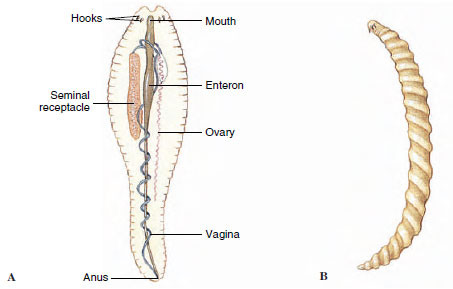Phylum Pentastomida
 |
| Figure 21-9 Two pentastomids. A, Linguatula, found in nasal passages of carnivorous mammals. Female is shown with some internal structures. B, Female Armillifer, a pentastomid with pronounced body rings. In parts of Africa and Asia, humans are parasitized by immature stages; adults (10 cm long or more) live in lungs of snakes. Human infection may occur from eating snakes or from contaminated food or water. |
Phylum Pentastomida
Pentastomida (pen-ta-stom´i-da) (Gr. pente, five, + stoma, mouth), or tongue worms, are a phylum of about 90 species of wormlike parasites of the respiratory system of vertebrates. Adults live mostly in lungs of reptiles, such as snakes, lizards, and crocodiles, but one species, Reighardia sternae, lives in air sacs of terns and gulls, and another, Linguatula serrata (Gr. lingua, tongue), lives in the nasopharynx of canines and felines (and occasionally humans). Although more common in tropical areas, they also occur in North America, Europe, and Australia.
Adults range from 1 to 13 cm in length. Transverse rings give their bodies a segmented appearance (Figure 21-9). The body is covered with a chitinous cuticle that is molted periodically during larval stages. The anterior end may bear five short protuberances (hence the name Pentastomida). Four of these bear claws. The fifth bears the mouth and two pairs of sclerotized hooks for attachment to the host tissues (Figure 21-10). There is a simple straight digestive system, adapted for sucking. The nervous system, similar to that of annelids and arthropods, has paired ganglia along the ventral nerve cord. The only sense organs appear to be papillae. There are no circulatory, excretory, or respiratory organs.
 |
| Figure 21-10 Anterior end of a pentastome. Note both the mouth (arrow), between the middle hooks, and the apical sensory papillae. |
Sexes are separate, and females are usually larger than males. A female may produce several million eggs, which pass up the trachea of the host, are swallowed, and pass out with feces. Larvae hatch out as oval, tailed creatures with four stumpy legs. Most pentastomid life cycles require an intermediate vertebrate host such as a fish, a reptile, or, rarely, a mammal, that is eaten by the definitive vertebrate host. After ingestion by an intermediate host, the larva penetrates the intestine, migrates randomly in the body, and finally metamorphoses into a nymph. After growth and several molts, the nymph finally becomes encapsulated and dormant. When eaten by a final host, the juvenile finds its way to the lung, feeds on blood and tissue, and matures.
Several species have been found encysted in humans, the most common being Armillifer armillatus (L. armilla, ring, bracelet, + fero, to bear), but usually they cause few symptoms. Linguatula serrata is a cause of nasopharyngeal pentastomiasis, or “halzoun,” a disease of humans in the Middle East and India.




